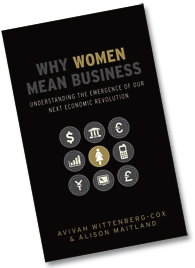 We asked one of our members, Elizabeth Harrin to review “Why Women Mean Business”. Elizabeth is a professional journalist and author, she also writes an award winning blog and has recently been nominated for our Project Manager of the Year award.
We asked one of our members, Elizabeth Harrin to review “Why Women Mean Business”. Elizabeth is a professional journalist and author, she also writes an award winning blog and has recently been nominated for our Project Manager of the Year award.
There’s a skills shortage. If you haven’t noticed it yet you will do when the baby boom generation starts to retire. There just aren’t enough people entering the workforce to keep up with demand, and meet the needs of my generation’s pension funds. Why Women Mean Business has the answer: women. We have better educational results but are under-represented in the workplace, especially at senior levels.
This book looks at the issues facing businesses today and presents ‘womenomics’ as a solution. It’s a book full of facts, research and real-life case studies based on extensive interviews, but it doesn’t rely on trotting out the old arguments. The authors say that in order to make the most of the talent that women represent companies need to understand the business imperatives of including them. It’s not about a slap-dash diversity programme and paying lip service to equality. It’s about bottom line financial results, and the customer and employee satisfaction that contributes to those results.
This book looks at the issues facing businesses today and presents ‘womenomics’ as a solution.”
There’s plenty of analysis to back that up: women in the US will control $22 trillion by 2010, and retailers missed out on £600m in 2007 by “failing to connect” with female customers. It’s in every company’s interest to make sure that a group with that much purchasing power is represented on the Board and at every level of management: you can’t serve your customers unless you know who they are. The authors say that companies need to become ‘gender-bilingual’ in order to succeed in challenging times, and that doing so will be better for men and women. Why Women Mean Business offers some practical guidelines for turning a company into a gender-bilingual organisation. For example, it talks about how recruiting practices unintentionally discriminate: roles that require an MBA are in the main filled by men because MBA courses need several years business experience, and by the time a women has that experience she could well be taking a career break to raise a family. That said, countries have a role to play too in supporting women at work through public policy. Wittenberg-Cox and Maitland dedicate a chapter to cultural differences and what countries can do to help businesses win the talent battle and retain women. Women are not offered paid maternity leave in the US, for example.
The first step to becoming bilingual is for companies to recognise that women are equal but different, and that the existing status quo might not be as unbiased as everyone thought. Recognising that men are a key part of addressing the leadership and business issues created by not using women’s talent in the workplace is also important. By doing this, companies will become employers of choice, be more successful and win a bigger slice of the pie.
This is an easy and interesting read, that will challenge your assumptions and open your eyes to differences in the workplace, as well as give you some practical tips for how to deploy successful gender initiatives in your company – or, if you aren’t responsible for that kind of thing, allow you to comment more effectively on what’s going on within your own organisation. It’s full of compelling arguments – let’s hope that the people who make policies are listening and that we start to see some gender initiatives with teeth.
Elizabeth Harrin
Elizabeth Harrin is author of the award-winning blog A Girl’s Guide to Project Management (http://www.pm4girls.co.uk/), and the book Project Management in the Real World (available on Amazon and in bookshops).
Twitter: pm4girls
http://www.elizabeth-harrin.com/
Read associated article from Elizabeth, How to get in to Project Management.
